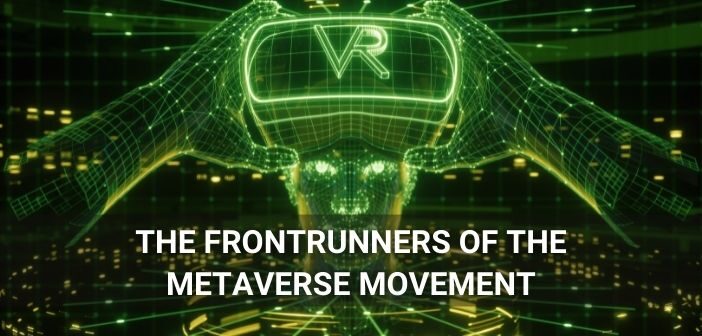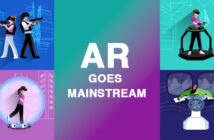As the technological advancements in AR, VR and XR reach market viability, tech giants worldwide are vying to win the largest piece of the pie of the future metaverse market. Just as the Internet revolution before, the first company to create a viable business model around the technology will be able to corner the market for themselves. All eyes are looking for the first metaverse “Killer App” – a scalable and universally applicable metaverse solution to all the communicational needs of the users around the world.
What is Metaverse exactly?
Metaverse is a concept coined by the novelist Neal Stephenson in his sci-fi novel “Snow Crash”, used to describe a completely immersive virtual world where all the people of the world interact, in place of their physical reality. Beyond that, the term is up for debate – there is no technical definition for it as there has been no comprehensive metaverse created before.
Due to the lack of a definition for the term, every company and entrepreneur who is in the running to create the first universally-applicable metaverse has a free hand in defining what the final product will look like. Any combination of the AR, VR and XR technology can be used to create the ultimate overlay to our reality – all it has to be is immersive, interactive and gamified.
 Image Courtesy: sdecoret from Adobe Stock
Image Courtesy: sdecoret from Adobe Stock
Yet, the creation of a comprehensive metaverse is a highly complicated task, involving the usage of many adjacent technologies – making it a task too large for small startups and individuals to carry out. Only organisations with large pockets and a ready pool of highly talented engineers – ergo, tech giants – can undertake such a venture and many such organisations are already in full swing to make metaverse a reality.
The following 4 tech giants have thrown their hats in the ring for creating the first “killer app” using metaverse technology:
Facebook Metaverse
In a recent press release by the CEO of Facebook, Mark Zuckerburg, he explicitly stated his vision for the company in the upcoming 5 years is to turn the famous social media platform into a “metaverse company”. Using the multiple platforms of mass communications that Facebook owns, the company aims to be the first comprehensive metaverse for all social interactions to take place.
To make this a reality, Facebook has created a separate wing for the task called Reality Labs – a team of engineers and designers with a strong background in game development. Apart from that, Facebook enjoys a massive advantage in implementing its vision due to the ownership of the VR company Oculus. Facebook is well placed in terms of technological expertise and the resources to make this transition.
 Image Courtesy: pressmaster from Adobe Stock
Image Courtesy: pressmaster from Adobe Stock
Microsoft Enterprise Metaverse
Beyond the interpretation of metaverses as an alternate reality to interact through, Microsoft envisions its metaverse as a natural extension to our current world. In a press note, they described the usage of technology as a tool to enhance the productivity of enterprises in all aspects.
Enabling IoT (internet of things) powered physical premises and creation of working models of business, premises and designs – Microsoft envisions the technology as a way to enable running enterprises with even richer data points and smarter decision making. The application of the technology is promised to be universal, providing data-driven modelling in all forms.
With a plethora of in-house technologies – Microsoft offers the unique proposition of a full-stack solution to enterprises across the board. One of their existing customers, AB InBev, is already using a part of the full-stack solution to refine their brewery and supply chain process. With the usage of the metaverse technology, the brewers at the AB InBev are assisted in their process with data and graphic models which are being updated every second, giving them an accurate gauge of the ingredients, supplies and logistics for maximising efficiency.
 Image Courtesy: ktasimar from Adobe Stock
Image Courtesy: ktasimar from Adobe Stock
Nvidia Omniverse
While most organisations are working on creating their Metaverse based solution or platform for creating amazing customer or professional experiences – NVIDIA has chosen to do the groundwork for all other organisations. The NVIDIA Omniverse aims to create a common graphic element language and module to enable all metaverses across all platforms. By using USD (Universal Scene Description), an open-sourced graphics language to create common virtual assets, the Omniverse will enable seamless switching from one metaverse to the other.
The Omniverse is a convergence of three technologies developed by NVIDIA which will serve as the basis of other metaverses. By creating a common graphic database and language of design, the company aims to create the main wireframe for future metaverses to come. The omniverse is available currently in beta version and has been used by architectural firms and city planners to create virtual simulations for better planning of projects and the creation of holodecks.
Roblox Metaverse
Gaming, especially Massive Multiplayer Online (MMOs) games, has been the closest in regards to creating a metaverse. With the increasing use of VR in households, Roblox – a sandbox-style virtual space where players can interact with each other through their 3D avatars in a customizable world – has gained massive traction. Hailed as the first proper metaverse game, Roblox is more than just a game – it is a virtual ecosphere where players, designers and companies can all interact with each other replete with its in-game economy.
 Image Courtesy: bodnarphoto from Adobe Stock
Image Courtesy: bodnarphoto from Adobe Stock
What sets Roblox apart from other free-roam interactive worlds such as “Second Life” and “Fortnite” is the scope of the game itself. Beyond being a 3D immersive interactive environment with gamification and avatars to interact with other people, the game has its currency and economy which supports more than 1.25 million creators worldwide who all have earned money from creating in-game items.
This is especially interesting as this economy can be a great way to even host NFT art pieces and art & fashion expos. One such event, the Gucci Garden Garden Experience was hosted on Roblox, with one of the tote bags from the collection going up for $4500 – this item can only be seen by other Roblox players in-game, showcasing the growing interest of players in their Roblox lives.
As more and more parallel technologies find compatibility with each other, the sci-fi dream of a world living all their experiences in a virtual world is coming to a head. In the words of Mark Zuckerburg “Metaverse is the natural extension of experiencing the internet”. With the inherent liking for immersive visual experiences and a lack of limitations, the world of the future is going to be inside a metaverse.




